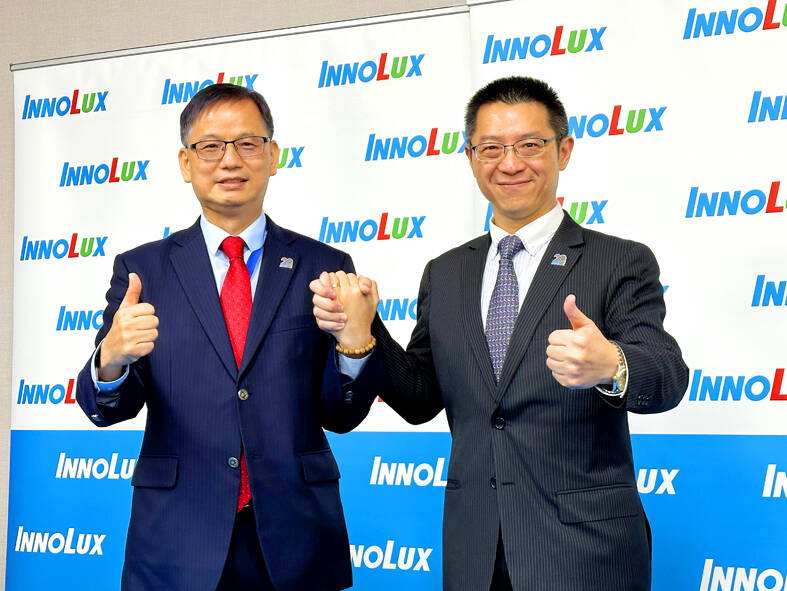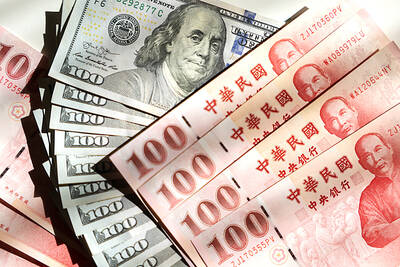Flat-panel maker Innolux Corp (群創) yesterday said it expects revenue momentum to improve in the second half of this year, thanks to recovering demand for panels used in TVs and laptops amid rebalancing supply-demand dynamics.
The Miaoli-based firm also expects the nascent upswing to extend into the next year, as the Olympic Games stimulate TV demand.
“The panel supply-demand situation is quite healthy. Upcoming major sports events next year would further increase demand for large TVs,” Innolux president James Yang (楊柱祥) told investors during a videoconference.

Photo: Chen Mei-ying, Taipei Times
Industrywide capacity control in the past few quarters played a key role in reviving demand, Yang said.
The rebound in demand also holds true for notebook computer panels, supported by back-to-school demand and rising replacement of higher-end commercial models, he said.
Capacity utilization this quarter is forecast to reach about 80 percent, the same as last quarter, Yang said.
The company expects a wave of computer replacements to emerge in the next two years as Microsoft Corp plans to end support for the Windows 10 operating system in 2025, Yang said, adding that it would also be a major catalyst for panel consumption.
Investors expressed concern over when Innolux’s bottom line would swing back to the black, after its gross margin returned to positive territory last quarter.
Gross margin came in at 0.6 percent last quarter, from minus-7 percent in the previous quarter, emerging from a three-quarter streak of negative margins. That compares with a gross margin of 1.2 percent a year earlier.
“The check point now is when we will start seeing a single-quarter net profit. We expect to see this [happen] the sooner the better,” Innolux chairman Jim Hung (洪進揚) said.
To boost the company’s resiliency, Innolux initiated a restructuring earlier this year, dividing its businesses into two groups: display and non-display.
The company also spun off its automotive displays and X-ray detectors to create two entities, CarUX Technology Pte Ltd (群豐駿) and InnoCare Optronics Corp (睿生光電), with the two providing major contributions to Innolux’s non-display revenue, Hung said.
Innolux expects revenue contribution from its non-display business to rise further from 22 percent of the company’s total revenue last quarter.
The company reported a net loss of NT$5.74 billion (US$181.5 million) in the April-to-June quarter, compared with a loss of NT$7.77 billion in the previous quarter. On an annual basis, the quarterly loss widened from a loss of NT$4.74 billion.
The company expects large flat-panel shipments this quarter to be flat compared with last quarter. Average selling prices are forecast to rise by a high-single-digit percentage this quarter, extending a price uptick of 6.67 percent last quarter on a sequential basis.
Sales of small and medium-sized panels are forecast to fall by a high-single-digit percentage sequentially, it said.

MARKET LEADERSHIP: Investors are flocking to Nvidia, drawn by the company’s long-term fundamntals, dominant position in the AI sector, and pricing and margin power Two years after Nvidia Corp made history by becoming the first chipmaker to achieve a US$1 trillion market capitalization, an even more remarkable milestone is within its grasp: becoming the first company to reach US$4 trillion. After the emergence of China’s DeepSeek (深度求索) sent the stock plunging earlier this year and stoked concerns that outlays on artificial intelligence (AI) infrastructure were set to slow, Nvidia shares have rallied back to a record. The company’s biggest customers remain full steam ahead on spending, much of which is flowing to its computing systems. Microsoft Corp, Meta Platforms Inc, Amazon.com Inc and Alphabet Inc are

Luxury fashion powerhouse Prada SpA has acknowledged the ancient Indian roots of its new sandal design after the debut of the open-toe footwear sparked a furor among Indian artisans and politicians thousands of miles from the catwalk in Italy. Images from Prada’s fashion show in Milan last weekend showed models wearing leather sandals with a braided design that resembled handmade Kolhapuri slippers with designs dating back to the 12th century. A wave of criticism in the media and from lawmakers followed over the Italian brand’s lack of public acknowledgement of the Indian sandal design, which is named after a city in the

The US overtaking China as Taiwan’s top export destination could boost industrial development and wage growth, given the US is a high-income economy, an economist said yesterday. However, Taiwan still needs to diversify its export markets due to the unpredictability of US President Donald Trump’s administration, said Chiou Jiunn-rong (邱俊榮), an economics professor at National Central University. Taiwan’s exports soared to a record US$51.74 billion last month, driven by strong demand for artificial intelligence (AI) products and continued orders, with information and communication technology (ICT) and audio/video products leading all sectors. The US reclaimed its position as Taiwan’s top export market, accounting for

INVESTOR RESILIENCE? An analyst said that despite near-term pressures, foreign investors tend to view NT dollar strength as a positive signal for valuation multiples Morgan Stanley has flagged a potential 10 percent revenue decline for Taiwan’s tech hardware sector this year, as a sharp appreciation of the New Taiwan dollar begins to dent the earnings power of major exporters. In what appears to be the first such warning from a major foreign brokerage, the US investment bank said the currency’s strength — fueled by foreign capital inflows and expectations of US interest rate cuts — is compressing profit margins for manufacturers with heavy exposure to US dollar-denominated revenues. The local currency has surged about 10 percent against the greenback over the past quarter and yesterday breached